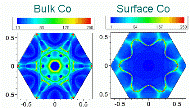Department of Physics and Astronomy: Publications and Other Research
Document Type
Article
Date of this Version
2012
Citation
THE JOURNAL OF CHEMICAL PHYSICS 136, 184301 (2012); http://dx.doi.org/10.1063/1.4706604
Abstract
Low-energy dissociative electron attachment (DEA) to the CF2Cl2 and CF3Cl molecules in a water cluster environment is investigated theoretically. Calculations are performed for the water trimer and water hexamer. It is shown that the DEA cross section is strongly enhanced when the attaching molecule is embedded in a water cluster, and that this cross section grows as the number of water molecules in the cluster increases. This growth is explained by a trapping effect that is due to multiple scattering by water molecules while the electron is trapped in the cluster environment. The trapping increases the resonance lifetime and the negative ion survival probability. This confirms qualitatively existing experiments on electron attachment to the CF2Cl2 molecule placed on the surface of H2O ice. The DEA cross sections are shown to be very sensitive to the position of the attaching molecule within the cluster and the orientation of the electron beam relative to the cluster.



Comments
Copyright 2012 American Institute of Physics. Used by permission.